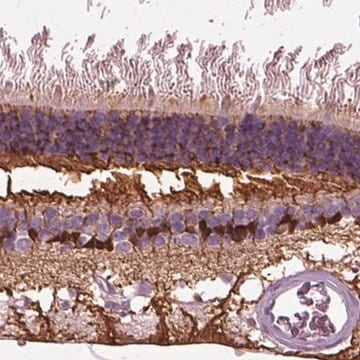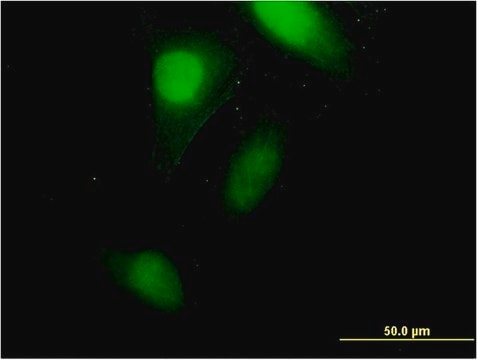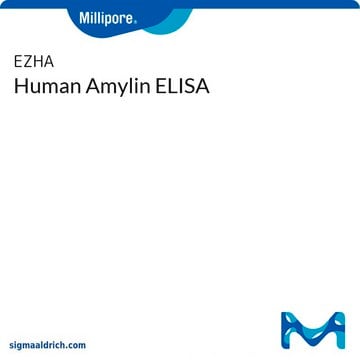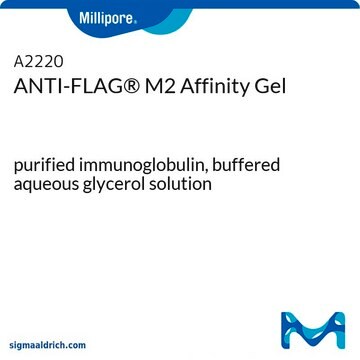推薦產品
生物源
mouse
品質等級
共軛
unconjugated
抗體表格
ascites fluid
抗體產品種類
primary antibodies
無性繁殖
C-1, monoclonal
形狀
buffered aqueous solution
分子量
antigen 16 kDa
物種活性
feline, turtle, monkey, rabbit, bovine, human, rat, chicken
應無反應活性
(chameleon), frog, goldfish
技術
indirect ELISA: suitable
western blot: suitable
UniProt登錄號
運輸包裝
wet ice
儲存溫度
−20°C
目標翻譯後修改
unmodified
基因資訊
human ... CRABP1(1381)
rat ... Crabp1(25061)
一般說明
Cellular retinoic acid-binding protein 1 is a protein encoded by the CRABP1 gene in humans. It encodes a specific binding protein for a vitamin A family member. It is also referred as RBP5, CRABP, CRABPI and CRABP-I.
免疫原
performic acid oxidized CRABP 1, purified from bovine retina.
應用
Applications in which this antibody has been used successfully, and the associated peer-reviewed papers, are given below.
Western Blotting (1 paper)
Western Blotting (1 paper)
Monoclonal Anti-Cellular Retinoic Acid Binding Protein 1 antibody produced in mouse is suitable for the following applications:
- indirect ELISA
- western blotting at a dilution of 1:1000
- immunofluorescence at a working dilution of 1:250
生化/生理作用
Cellular retinoic acid-binding protein 1 (CRABP1) is a prognostic marker for adenocarcinoma and clear cell carcinoma that exhibits chemo-resistance. It is a is a modulator of retinoic acid and plays an important role in retinoic acid-mediated differentiation and proliferation processes. CRABP1 also functions as a tumor-suppressor in esophageal epithelium and its epigenetic silencing may play a pivotal role during esophageal carcinogenesis.
外觀
Solution in phosphate buffered saline containing 0.05% sodium azide.
免責聲明
Unless otherwise stated in our catalog or other company documentation accompanying the product(s), our products are intended for research use only and are not to be used for any other purpose, which includes but is not limited to, unauthorized commercial uses, in vitro diagnostic uses, ex vivo or in vivo therapeutic uses or any type of consumption or application to humans or animals.
未找到適合的產品?
試用我們的產品選擇工具.
儲存類別代碼
10 - Combustible liquids
水污染物質分類(WGK)
nwg
閃點(°F)
Not applicable
閃點(°C)
Not applicable
個人防護裝備
Eyeshields, Gloves, multi-purpose combination respirator cartridge (US)
Yu-Lung Lin et al.
Endocrinology, 158(9), 3004-3014 (2017-09-16)
Retinoic acid (RA) is the active ingredient of vitamin A. It exerts its canonical activity by binding to nuclear RA receptors (RARs) to regulate gene expression. Increasingly, RA is also known to elicit nongenomic RAR-independent activities, most widely detected in
Yi-Chiung Hsu et al.
Molecular carcinogenesis, 62(12), 1935-1946 (2023-08-29)
Cellular retinoic acid binding protein 1 (CRABP1) participates in the regulation of retinoid signaling. Previous studies showed conflicting results regarding the role of CRABP1 in tumor biology, including protumorigenic and tumor-suppressive effects in different types of cancer. Our bioinformatics analyses
Sung Wook Park et al.
The Journal of endocrinology, 236(3), 151-165 (2018-01-27)
Excessive and/or persistent activation of calcium-calmodulin protein kinase II (CaMKII) is detrimental in acute and chronic cardiac injury. However, intrinsic regulators of CaMKII activity are poorly understood. We find that cellular retinoic acid-binding protein 1 (CRABP1) directly interacts with CaMKII
M W Kelley et al.
Development (Cambridge, England), 119(4), 1041-1053 (1993-12-01)
The mammalian organ of Corti has one of the most highly ordered patterns of cells in any vertebrate sensory epithelium. A single row of inner hair cells and three or four rows of outer hair cells extend along its length.
Shawna D Persaud et al.
Scientific reports, 6, 22396-22396 (2016-03-05)
All trans retinoic acid (atRA) is one of the most potent therapeutic agents, but extensive toxicity caused by nuclear RA receptors (RARs) limits its clinical application in treating cancer. AtRA also exerts non-genomic activities for which the mechanism remains poorly
Active Filters
我們的科學家團隊在所有研究領域都有豐富的經驗,包括生命科學、材料科學、化學合成、色譜、分析等.
聯絡技術服務








